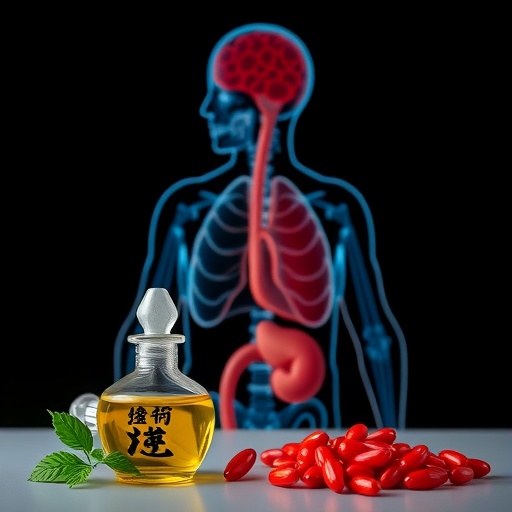In an era where chronic hepatitis B (CHB) continues to pose significant global health challenges despite advances in antiviral therapies, a novel approach combining traditional and modern medicine is showing promising results. Peginterferon-α (PEG-IFN α) remains a cornerstone in the management of CHB due to its capacity to induce viral suppression and immune modulation. However, its clinical utility is constrained by modest serological response rates and notable adverse effects such as myelosuppression, which often leads to treatment discontinuation. Emerging evidence now highlights the potential benefits of integrating Traditional Chinese Medicine (TCM) alongside PEG-IFN α-2b, offering both enhanced antiviral efficacy and a reduction in treatment-related hematological toxicities.
A recent comprehensive real-world cohort study conducted at Xiamen Hospital of TCM evaluated the therapeutic synergy between PEG-IFN α-2b and specific TCM formulations in treating HBeAg-positive CHB patients. The study enrolled 117 patients who were stratified into two groups: one receiving PEG-IFN α-2b monotherapy, and the other receiving the same antiviral regimen supplemented with a customized TCM decoction composed primarily of Licorice, Angelica sinensis, Poria, Paeonia lactiflora, Rhizoma Atractylodis Macrocephalae, Radix Bupleurum Chinense, Mentha piperita, and ginger. The herbal combination was administered consistently for more than six months, allowing assessment of both virological responses and hematologic safety parameters.
The novel integrative treatment arm demonstrated superior clinical outcomes compared to PEG-IFN α-2b alone. Quantitative analyses revealed significantly greater reductions in hepatitis B surface antigen (HBsAg) levels at both 24 and 48 weeks, highlighting improved immune clearance of viral particles. Additionally, the serological conversion rates of hepatitis B e antigen (HBeAg) markedly increased in the combination group, suggesting enhanced immune-mediated viral control. Most notably, by week 48, the group receiving adjunctive TCM exhibited an almost doubled HBV DNA negative conversion rate compared to controls, indicating profound suppression of viral replication.
Mechanistically, PEG-IFN α exerts antiviral effects through induction of innate and adaptive immune responses, including activation of natural killer cells and cytotoxic T lymphocytes. However, its systemic toxicity primarily attributed to bone marrow suppression hampers sustained therapy. The TCM herbal concoction used encompasses bioactive compounds reputed for immunomodulatory, hepatoprotective, and anti-inflammatory properties. For instance, Licorice contains glycyrrhizin, known for its hepatoprotective and anti-fibrotic effects, while Angelica sinensis has immunoregulatory capabilities enhancing cytokine balance. These components likely contribute to not only potentiating antiviral immunity but also mitigating myelosuppression observed in interferon monotherapy.
Safety profiles from the study reinforce the clinical promise of this integrative strategy. Incidence of treatment-associated myelosuppression — which includes significant reductions in white blood cells, red blood cells, and platelets — was substantially lower in patients receiving combined therapy at both mid and end points of treatment assessment. This improvement in hematologic tolerance could lead to better patient adherence and prolonged duration of effective antiviral intervention, a critical factor in achieving sustained virological response in chronic hepatitis B.
This real-world investigation adds to mounting evidence favoring adjunctive TCM approaches in the management of chronic viral hepatitis. Unlike controlled trial settings, real-world studies capture a broader patient demographic and reflect routine clinical practice, thereby enhancing the generalizability of the findings. The methodology entailed meticulous retrospective analysis of etiological markers, liver function tests, and complete blood counts before and after therapy, underscoring the robustness of the data.
Beyond virological and hematological endpoints, the integrative regimen may confer additional hepatoprotective effects through attenuation of liver inflammation and fibrosis progression, potentiated by the complex phytochemical interactions in TCM formulations. This holistic benefit aligns with TCM principles emphasizing systemic balance and immune homeostasis, thereby complementing the targeted actions of PEG-IFN α.
Given the global burden of CHB and the limitations of existing therapeutics, these findings advocate for incorporating traditional medicinal knowledge into mainstream antiviral regimens. While the study opens new avenues for treatment optimization, further randomized controlled trials with larger cohorts and mechanistic explorations are warranted to elucidate precise pathways by which TCM components enhance antiviral efficacy and safety.
In conclusion, the integration of Traditional Chinese Medicine with peginterferon α-2b represents a promising therapeutic advance for HBeAg-positive chronic hepatitis B patients. This combination not only significantly improves antiviral outcomes by increasing serological conversion rates and viral clearance but also importantly reduces adverse myelosuppressive effects, thereby supporting sustained and effective treatment courses. Such strategies may redefine interferon-based therapy paradigms and inspire cross-disciplinary innovations in chronic viral disease management.
The study, recently published in the esteemed journal Future Integrative Medicine, marks an important milestone in bridging ancient medical wisdom with contemporary biochemical interventions. As chronic hepatitis B continues to challenge the medical community, integrative approaches like this offer a beacon of hope for enhancing patient outcomes and quality of life.
Subject of Research: Chronic hepatitis B treatment efficacy and safety enhancement using Traditional Chinese Medicine combined with peginterferon α-2b.
Article Title: Traditional Chinese Medicine Combined with Peginterferon α-2b in Chronic Hepatitis B: A Real-world Cohort Study
News Publication Date: 18-Sep-2025
Web References:
Future Integrative Medicine journal: https://www.xiahepublishing.com/journal/fim
DOI link: http://dx.doi.org/10.14218/FIM.2025.00020
Keywords: Chronic hepatitis B, Peginterferon α-2b, Traditional Chinese Medicine, antiviral therapy, serological conversion, myelosuppression, liver inflammation, herbal medicine, immune modulation, HBeAg, HBV DNA, hepatoprotection
Tags: antiviral therapy advancementschronic hepatitis B treatmentcustomized TCM decoction for hepatitis B.HBeAg-positive CHB patientsmyelosuppression in hepatitis therapyPeginterferon α-2b therapyreal-world cohort studysynergistic effects of TCM and PEG-IFNTCM herbal formulationsTraditional Chinese Medicine integrationtreatment-related hematological toxicitiesvirological response rates





